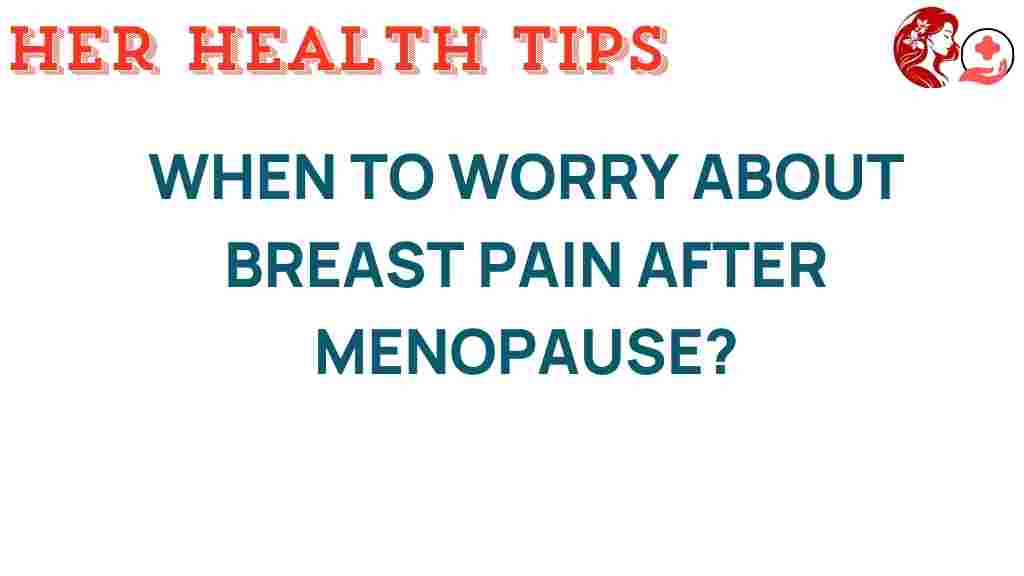Unraveling the Mystery: When Should You Worry About Breast Pain Post-Menopause?
Breast pain, also known as mastalgia, can be a concerning symptom for many women, especially those who are post-menopausal. Understanding the causes, implications, and when to seek medical advice is crucial for maintaining good women’s health. In this article, we will explore the relationship between menopause and breast pain, the hormonal changes that occur, and the symptoms to watch for that may indicate a need for further investigation.
Understanding Breast Pain and Menopause
During the transition into menopause, which typically occurs between the ages of 45 and 55, women experience significant hormonal changes. The decrease in estrogen and progesterone levels can lead to various symptoms, including fluctuations in breast tissue, which may result in discomfort or pain.
Breast pain can be categorized into several types:
- Cyclical breast pain: Often linked to hormonal changes associated with the menstrual cycle, though less common post-menopause.
- Non-cyclical breast pain: This type of pain may arise from various factors such as trauma, infections, or cysts.
- Localized pain: Pain that occurs in a specific area of the breast, which may indicate issues such as a lump or infection.
Symptoms of Concern
While breast pain can be a normal part of aging and hormonal changes, certain symptoms should raise alarms. If you experience any of the following, it is essential to seek medical advice:
- Persistent pain: Pain that does not go away or worsens over time.
- New lumps: Any noticeable lumps or changes in breast texture should be evaluated.
- Nipple discharge: Any unusual discharge from the nipples, especially if it is bloody or clear.
- Skin changes: Changes in the skin of the breast, such as redness, swelling, or a rash.
- Unexplained weight loss: Significant weight loss without changes in diet or exercise.
When to Seek Medical Advice
It is vital to consult a healthcare professional if you experience any concerning symptoms. Post-menopausal women should have regular check-ups that include a clinical breast examination and mammograms as recommended by their healthcare provider. Here are steps to consider when addressing breast pain:
Step 1: Keep a Symptom Diary
Tracking your symptoms can help you identify patterns. Note the following:
- When the pain occurs.
- The intensity of the pain (on a scale of 1-10).
- Any accompanying symptoms (e.g., lumps, discharge).
- Any potential triggers (e.g., physical activity, certain bras).
Step 2: Schedule a Doctor’s Appointment
Once you have documented your symptoms, schedule an appointment with your healthcare provider. Be prepared to discuss:
- Your medical history, including any family history of breast cancer.
- All medications you are currently taking.
- Any recent changes in your health or lifestyle.
Step 3: Diagnostic Tests
Your doctor may recommend several tests to assess your breast health, including:
- Mammogram: A low-energy X-ray used to examine the breast tissue.
- Ultrasound: This imaging test uses sound waves to visualize breast tissue.
- Biopsy: If a lump is present, a biopsy may be performed to determine if it is benign or malignant.
Hormonal Changes and Breast Health
The hormonal changes experienced during menopause can have a profound impact on breast tissue. Estrogen influences the density and structure of breast tissue, and its reduction can lead to:
- Fatty tissue replacement: As glandular tissue decreases, it is often replaced by fatty tissue, which can be less sensitive.
- Changes in breast shape and size: Many women notice a change in breast size or firmness.
- Increased sensitivity: Some women may experience increased sensitivity or discomfort in their breast tissue.
Troubleshooting Tips for Managing Breast Pain
If you are experiencing breast pain post-menopause, there are several strategies you can implement to help alleviate discomfort:
- Wear a supportive bra: A well-fitted bra can reduce strain on breast tissue and provide comfort.
- Apply warm or cold compresses: Heat or cold therapy can help soothe painful areas.
- Manage stress: Stress can exacerbate pain; consider relaxation techniques such as yoga or meditation.
- Stay active: Regular physical activity can improve overall health and reduce discomfort.
- Consult about dietary changes: A balanced diet rich in fruits, vegetables, and whole grains can support overall well-being.
Conclusion
Understanding breast pain and its relationship with menopause is crucial for maintaining optimal women’s health. While hormonal changes can lead to discomfort, it is essential to remain vigilant. If you experience persistent or concerning symptoms, seek medical advice promptly. By staying informed and proactive about your breast health, you can navigate the changes that come with menopause with greater ease and confidence.
For more information on women’s health issues and resources, visit this informative site. Remember, your health is your wealth, so prioritize your well-being today!
This article is in the category Reproductive and created by HerHealthTips Team
